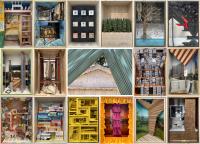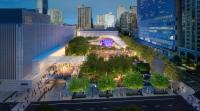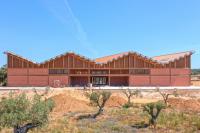Reception Center, Minhang Ecological Garden
Shanghai, China
Context
The 4,400-square-meter project is located within an urban park (the Ecological Garden) in a dense residential and industrial area of Minhang, Shanghai. It consists of the Park Administration and two reception facilities. Named as “Village of Reeds” and “Secluded Place”, the two facilities meet local communities’ growing need to have landscaped settings for small-group conferences and retreats. People enter the three parts from separated entries along the west side of the building complex.
Design Concepts
1. The Courtyard Tradition
With the current dominance of Western culture in China, the standard solution for such a project would be three freestanding buildings surrounded by lawns. We rejected this model, suggested to us by the owner, because the exposed outdoor spaces would be useless near a park in a high-density city. Inspired by the courtyard tradition, we decentralized the building mass and internalized outdoor space as courtyards. Walls separate the Center from the park and the three parts from each other. This allows users to have privacy while enjoying nature, a popular way to relax in Chinese culture.
2. The Visual Channels -- A Critique of the Tradition
To avoid the complete isolation associated with traditional courtyards, we created a variety of openings on the walls to form visual channels. They allow users to have glimpses of the other courtyards and the park beyond, expanding their sense of space and linking them to the public life outside. The main channel, a north-south canal, penetrates all three parts of the Center. Additional channels of east-west direction are provided through slits on the walls. The front of the Park Administration facing the street has a double-layered façade, completing the hidden-and-reveal boundary.
3. Pairs of Indoor and Outdoor Spaces
Each major room in the design is paired with an outdoor space to jointly serve one function. Much loved by the Chinese, the pattern contrasts with the Western model that tends to group indoor and outdoor spaces into two separated categories. To improve on the tradition, second-floor rooms also have their roof-top patios. The numerous outdoor spaces are given different shapes and ambiances to highlight their various functions.
4. Local Landscape Patterns
The design of the gardens in this project borrows patterns from local rural landscape, such as the reed-bordered waterways and the fishponds, but in an abstracted way to create a symbolized nature. The reeds now have grown to 1.5 meter high as intended, which also serve as a screen "wall" between the conference hall and the more private area in "Village of Reeds."
5. Low-Tech Construction and Material
Due to the limited budget and local labor's skill, the design selects a hybrid structural system in which masonry bearing wall and site-cast concrete framing (slender than one used alone) work together. Frequently used among low-end, low-rise construction in China, the system has a good thermal value, can resist earthquakes up to intensity VII, while still allows for some large openings in the spatial configuration. It especially suits this scheme that calls for many space barriers. In addition, this design revives a few ancient techniques such as the brick lattice wall.
Publication/Award
Journals A+ (Belgium, Vol. 211, 2007), Detail (Germany, Chinese Edition, 1/2006), Dialogue (Taiwan, Vol. 122, 2008), Architectural Journal (China, 5/2005), Time+Architecture (China, 5/2004), Architecture Asia (Asia, 3/2009), and book Domus+78 Chinese Architects and Designers (2006)
Design Merit Award, The Sixth Far Eastern Architectural Awards, Taiwan, 2007.
Exhibited at the 2005 First Shenzhen Biennial of Urbanism\Architecture, Shenzhen, China, 2005-2006


- arkkitehdit
- Pu Miao
- Location
- Dongchuan Road at Kunyang Road, Shanghai, China
- Year
- 2004
- Client
- Shanghai Minhang United Development Co. Ltd.
- Team
- Pu Miao
- Engineering
- Shanghai Landscape Architecture Design Institute












